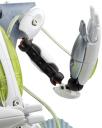Good day, everyone.
We’ve done three crowdfunding features here on Robot Central so far and today we’re going to check in on how these campaigns are doing. These projects, and the ones we will cover in the future, are bots that struck our interest for their usefulness, coolness and possible applicability in the marketplace. They, in some way, represent the democratization of development we’re fond of.
The first feature we did was for the Koule Ball from Que Innovations. This neat invention is an interactive ball that is, and can be, programmed with games that fulfill different purposes. The initial aim of the invention was to help autistic kids practice emotional involvement and social acclimation, but it can be used for developing the skills of all children.
When we covered the Koule ball campaign, they were 22 days left and $1,893 out of $200,000 has been raised. As of writing this article, I am unable to find the original Indiegogo page and so I cannot determine if they reached their goal. If you would like to learn more about the project, you can visit Que Innovations’ website here.
Our next feature was Autom, a robotic weight loss coach. The rundown for her:
Autom, a weight-loss coach, is our crowdfunding feature of the day. She’s a robot that helps you keep tabs on how well you diet, and she does so by being humanly and informed. The robot has been in development for the last five years, and it is now ready for mass manufacture. The developer, Dr. Cory Kidd, started the Indiegogo pageso his company, Intuitive Automata, can ship Autom to dieters quicker.
At the time of running that feature, the Flexible Funded project raised $6,588 out of the $50,000 goal. There were 19 days left in the campaign. As of today, there 2 and a half days left in the campaign and they stand at $7,286 out of the $50,000 sought.
Finally, the last campaign we covered was the Kubi telepresence robot. The great thing about this invention is that it brings telepresence into the realm of common use. As it stands, most conference robots on the market easily hit a five-figure price tag, and it’s primarily in the robot’s ability to move around the room. With the Kubi, it stays stationary and works with your iPad or other tablet computer. The Kubi can be remotely controlled by the person you’re talking to, giving a personalized experience.
The creators of the Kubi were gracious enough to speak with us, and we asked them why they felt the need for a robot like Kubi:
“Dealing with webcams, propping up tablets on books and stationary stands was a major pain. Especially with my daughter, I would end up chasing her around the room with a laptop so grandma can keep bonding. For many people this may seem like a first world problem but for someone trying to bond and carry on a relationship, the Kubi makes a huge difference. We [Polyakov and Rosenthal] are engineers who saw and experienced a clear problem we had to solve. Being on the remote end and not being able to follow someone who walks out of frame or missing stuff right outside your field of view is extremely distancing.”
At the time of the article, the Flex Funded Indiegogo campaign raised $12,039 out of the $200,000 goal needed to kick off mass production. As of today, they have raised $18, 428 and there is 28 days left in the campaign. If they get the funding needed, the estimated delivery date of the robot will be Spring 2013.
In the future, we hope to see more robotic and advanced technology related campaigns up on Indiegogo and Kickstarter. We’ll keep on that beat for y’all and bring any interesting campaign to light.















